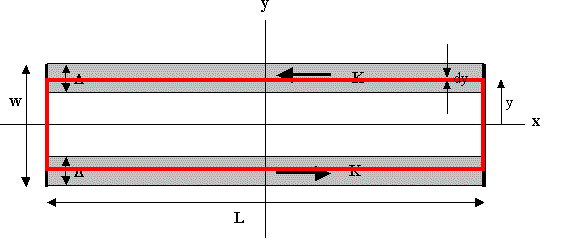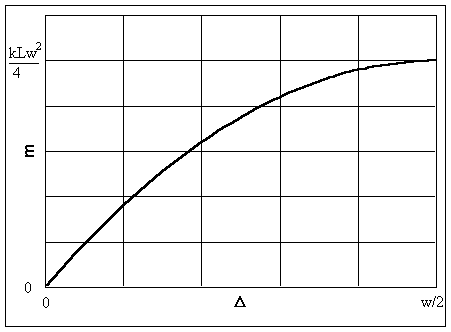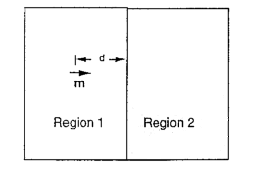Magnetic dipole moment and dipole field
Problem:
A circular loop of wire with radius a = 1 cm
and center at the origin is bent, so half lies in the y-z plane and
half in the x-y plane. A current I = 2 A flows in the wire.
(a) What is the magnetic moment of this loop?
(b) What is the magnetic field at (x, y, z) = (3, 4, 0) meters from the
origin?
Solution:
- Concepts:
The magnetic moment of a current loop, the principle of superposition, the
dipole field
- Reasoning:

We can view the loop as a superposition of loop 1 and loop 2 as shown.
We find m by adding the moments of loop 1 and loop 2,
m =
m1
+ m2.
- Details of the calculation:
(a) m1 = (-i)Iπa2/2,
m2 = (-k)Iπa2/2,
m = (-i - k)Iπa2/2, m
= Iπa2/2½. (SI units
The distance from the origin to the point where we want to know the field is much greater that the dimensions of the
loop. The magnetic field is therefore the dipole field.
B(r) = (μ0/4π)(3(m·r)r/r5
- m/r3),
r = 3i
+ 4j, r = 5.
m∙r = -3Iπa2/2,
(m∙r)r = (-9Iπa2/2)i
+ (-6Iπa2)j,
3(m∙r)r/r2 -
m =
(-27Iπa2/50)i - (18Iπa2/25)j
+ (i + k)Iπa2/2
= [(-2/50)i
- (18/25)j + ½k)]Iπa2.
B(r) = (μ0/4π)(Iπa2/50)[-i
- 36j + 25k]/125
= (10-7/125)(2π10-4/50)[-2i
- 36j + 25k] = 10-14 [-2i - 36j + 25k].
Problem:
A
thin rectangular sheet of composite material has dimensions L x w
with L >> w. The sheet carries a steady surface current that circulates as
shown.
A surface current density K
= dI/dy = constant
flows in the x direction over a width ∆. At the ends of
the rectangle
(x = ± L/2) a high conductance "short
circuit" completes the current path.
(a)
Find the magnetic moment m.
(b)
Sketch the magnitude of m as a function of the width ∆
of the current.

Solution:
- Concepts:
The magnetic moment
- Reasoning:
We are asked to find the magnetic moment of a current distribution.
When you get a problem that asks you to find the
magnetic moment of a current distribution, the method that you should think of
first is using the principle of superposition. Try to divide the current
distribution into individual flat current loops with magnetic moment
m =
IAn, and add (integrate) the magnetic moments of the loops (vector
addition).
- Details of the calculation:
(a)
Consider a loop as shown above. For this filamentary loop dm =
k(Kdy)2Ly.
m = ∫dm = k ∫w/2-∆w/2dy 2KLy
= k KL∆ (w - ∆).
(b)

Problem:
Assume a "Bohr-type model" of the He atom. Each
electron is in circular orbit of radius 3.95*10-11 m around a nucleus
with effective charge Zeff = 1.34.
The electrons orbit in a plane perpendicular to the z-axis, with opposite sense
of rotation.
(a) What is the magnitude of the magnetic moment of each electron due to
its
motion?
(b) What is the total magnetic moment of the atom? (Ignore spin.)
(c) Assume a magnetic field B = B0k is turned on.
If the radius of the electron orbits does not change, but the electron speed
changes by
±dv, what is the total magnetic
moment of the atom now (ignoring terms higher than first order in dv)?
Solution:
- Concepts:
The magnetic moment, the Lorentz force, F = q(E + v
x B)
- Reasoning:
The Coulomb force is the only radial force responsible for the
centripetal acceleration when no magnetic field is present.
If a magnetic field is turned on Fm = qv
x B
also contributes. For the electron moving ccw in the xy-plane the Ftotal
> FCoulomb and for the electron moving cw in the xy-plane the Ftotal
> FCoulomb.
- Details of the calculation:
(a) For each of the electrons Mev2/r = keZeffqe2/r2, v2 = keZeffqe2/(Mer),
v = 2.93*106 m/s.
m = IA. I = qev/(2πr) = amount of charge that passes a
point on the orbit per unit time.
m = qevπr2/(2πr) = qevr/2
= 9.26*10-24 J/T.
(b) mtotal = 0. The magnetic moment of the cw moving electron
points into the +k direction while the magnetic moment of the ccw
moving electron
points into the -k direction.
(c) Me(v + dv)2/r = keZeffqe2/r2
± qe(v + dv)B0
2Mev dv/r = ±q(v + dv)B0, dv ≈ ±qeB0r/(2Me),
ignoring terms in (dv)2.
For the ccw moving electron: dm = qedvr/2 = +qeB02r2/(4Me).
The magnitude of the magnetic moment pointing in the -k direction
increases.
For the cw moving electron: dm = -qedvr/2 = -qeB02r2/(4Me).
The magnitude of the magnetic moment pointing in the +k direction
decreases.
mtotal = -2qeB02r2/(4Me)k.
mtotal is anti-parallel to
B.
Problem:
A point magnetic dipole m in vacuum (region 1 in the diagram below) is
pointing toward (and is normal to) the plane surface of a material with
permeability μ (region 2). The distance between
the dipole and the surface is d.
(a) Use the method of images to find the magnetic field
B in both
regions, as follows: Place an image dipole m' = αm a distance d into medium 2 and take the field
B1
in region 1 to be due to dipoles m and
m'
in a medium with
μ0. Take the field B2 in region 2 to be due to a single dipole
m" =
βm at the location of
the real dipole m in a medium with μ. Solve the boundary value problem at the
interface to evaluate B1 and
B2.
(b) Describe physically how each of the image dipoles
m' and
m"
arise and the role they play in determining the fields and the forces on the
real dipole and the material of medium 2.
(c) Evaluate the force acting on the dipole m.

Solution:
- Concepts:
The magnetic field of a dipole
- Reasoning:
For a dipole at r' in a medium
with permeability μ
we have
B(r) = (μ/(4π))[3(m∙r'')r''/r''5
- m/r''3], with
r'' =
r - r'.
We must find the superposition of two dipole fields which satisfies the
boundary conditions at the interface.
- Details of the calculation:
(a) Assume that in region 1 B is the same as that of a dipole
m = mk at z = -d and a dipole αmk
at z = d.
Assume that in region 2 B is the same as that of a dipole
βmk at z = -d. Let the z = 0 plane be the boundary between
regions 1 and 2.
Boundary conditions at z = 0:

B1∙n2 =
B2∙n2,
the normal component of B is continuous.
H1 x n =
H2 x n,
the tangential component of H is continuous.
Let
r = xi
specify a location in the xy-plane, then
B1(x,0,0)∙k
= (μ0/(4π))[3md2/(x2
+ d2)5/2 - m/(x2 + d2)3/2]
+ (μ0α/(4π))[3md2/(x2
+ d2)5/2 - m/(x2 + d2)3/2].
B1∙n =
B1∙k
= (1 + α)(μ0/(4π))[3md2/(x2
+ d2)5/2 - m/(x2 + d2)3/2]
B2∙n =
B2(x,0,0)∙k
= (μβ/(4π))[3md2/(x2
+ d2)5/2 - m/(x2 + d2)3/2]
To satisfy the boundary conditions we need (1 + α)μ0
= μβ.
H1∙i = (1/(4π))[3mdx/(x2
+ d2)5/2] - (α/(4π))[3mdx/(x2
+ d2)5/2]
= (1 - α)(1/(4π))[3mdx/(x2
+ d2)5/2]
H2∙i = (β/(4π))[3mdx/(x2
+ d2)5/2]
To satisfy the boundary conditions we
need (1 - α) = β,
(1 + α)μ0=
(1 - α)μ.
Therefore α = (μ
- μ0)/(μ +
μ0), β
= 2μ/(μ +
μ0).
The field everywhere in region 1 is
B(r)
= (μ0/(4π))[3(m∙r1)r1/r15
- m/r13
+ ((μ -
μ0)/(μ +
μ0))(3(m∙r2)r2/r25
- m/r23)],
with
r1 =
r + di,
r2
= r - di.
The field everywhere in region 2 is
B(r)
= (2μ/(μ +
μ0))(μ/(4π))[3(m∙r1)r1/r15
- m/r13].
(b)
The field of the dipole m magnetizes the material. This
produces magnetization currents.
jm =
∇×M,
km =
M×n.
Here
jm = 0, the magnetization currents are surface
currents. This surface current density produces the fields in region 1
that are attributed to the image dipole αm.
In region 2 the dipole m and the surface currents together produce
the same field as the image dipole βm.
(c) The force on the dipole
m is
F =
∇(B∙m),
where B is the field due to the image dipole αm
at the location of m.
B(-dk) = (μ0/(4π))((μ
- μ0)/(μ +
μ0)(2m/(2d)3)k.
B∙m = -(μ0/(4π))((μ
- μ0)/(μ +
μ0)(2m2/(2z)3)|z=-d.
∇(B∙m)|z=-d
= (3μ0/(4π))((μ
- μ0)/(μ +
μ0)(2m2/8d4)k
= (μ0/(4π))((μ
- μ0)/(μ +
μ0)(6m2/8d4)k.
F = (μ0/(4π))((μ
- μ0)/(μ +
μ0)(6m2/8d4)k.






